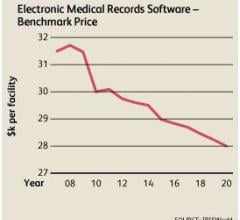
Sept. 25, 2012 — America's healthcare system has become too complex and costly to continue business as usual, says a new report from the Institute of Medicine. Inefficiencies, an overwhelming amount of data and other economic and quality barriers hinder progress in improving health and threaten the nation's economic stability and global competitiveness, the report says. However, the knowledge and tools exist to put the health system on the right course to achieve continuous improvement and better quality care at lower cost, added the committee that wrote the report.
The costs of the system's current inefficiency underscore the urgent need for a systemwide transformation. The committee calculated that about 30 percent of health spending in 2009 — roughly $750 billion — was wasted on unnecessary services, excessive administrative costs, fraud and other problems. Moreover, inefficiencies cause needless suffering. By one estimate, roughly 75,000 deaths might have been averted in 2005 if every state had delivered care at the quality level of the best performing state.
Incremental upgrades and changes by individual hospitals or providers will not suffice, the committee said. Achieving higher quality care at lower cost will require an across-the-board commitment to transform the U.S. health system into a "learning" system that continuously improves by systematically capturing and broadly disseminating lessons from every care experience and new research discovery. It will necessitate embracing new technologies to collect and tap clinical data at the point of care, engaging patients and their families as partners, and establishing greater teamwork and transparency within healthcare organizations. Also, incentives and payment systems should emphasize the value and outcomes of care.
"The threats to Americans' health and economic security are clear and compelling, and it's time to get all hands on deck," said committee chair Mark D. Smith, president and CEO, California HealthCare Foundation, Oakland. "Our healthcare system lags in its ability to adapt, affordably meet patients' needs and consistently achieve better outcomes. But we have the know-how and technology to make substantial improvement on costs and quality. Our report offers the vision and road map to create a learning healthcare system that will provide higher quality and greater value."
The ways that healthcare providers currently train, practice and learn new information cannot keep pace with the flood of research discoveries and technological advances, the report says. How healthcare organizations approach care delivery and how providers are paid for their services also often lead to inefficiencies and lower effectiveness and may hinder improvement.
Better use of data is a critical element of a continuously improving health system, the report says. About 75 million Americans have more than one chronic condition, requiring coordination among multiple specialists and therapies, which can increase the potential for miscommunication, misdiagnosis, potentially conflicting interventions and dangerous drug interactions. Health professionals and patients frequently lack relevant and useful information at the point-of-care where decisions are made. And it can take years for new breakthroughs to gain widespread adoption; for example, it took 13 years for the use of beta blockers to become standard practice after they were shown to improve survival rates for heart attack victims.
Mobile technologies and electronic health records (EHRS) offer significant potential to capture and share health data better. The National Coordinator for Health Information Technology, IT developers and standard-setting organizations should ensure that these systems are robust and interoperable, the report says. Clinicians and care organizations should fully adopt these technologies, and patients should be encouraged to use tools, such as personal health information portals, to actively engage in their care.
Healthcare costs have increased at a greater rate than the economy as a whole for 31 of the past 40 years. Most payment systems emphasize volume over quality and value by reimbursing providers for individual procedures and tests rather than paying a flat rate or reimbursing based on patients' outcomes, the report notes. It calls on health economists, researchers, professional societies and insurance providers to work together on ways to measure quality performance and design new payment models and incentives that reward high-value care.
Although engaging patients and their families in care decisions and management of their conditions leads to better outcomes and can reduce costs, such participation remains limited, the committee found. To facilitate these interactions, healthcare organizations should embrace new tools to gather and assess patients' perspectives and use the information to improve delivery of care. Healthcare product developers should create tools that assist people in managing their health and communicating with their providers.
Increased transparency about the costs and outcomes of care also boosts opportunities to learn and improve and should be a hallmark of institutions' organizational cultures, the committee said. Linking providers' performance to patient outcomes and measuring performance against internal and external benchmarks allows organizations to enhance their quality and become better stewards of limited resources, the report says. In addition, managers should ensure that their institutions foster teamwork, staff empowerment and open communication.
The report was sponsored by the Blue Shield of California Foundation, Charina Endowment Fund and Robert Wood Johnson Foundation. Established in 1970 under the charter of the National Academy of Sciences, the Institute of Medicine provides objective, evidence-based advice to policymakers, health professionals, the private sector and the public. The Institute of Medicine, National Academy of Sciences, National Academy of Engineering and National Research Council together make up the independent, nonprofit National Academies.
For more information, visit http://national-academies.org or http://iom.edu.


 June 14, 2024
June 14, 2024 








